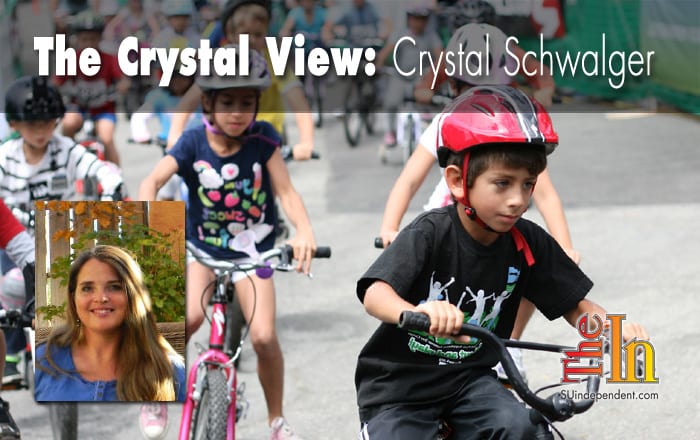 |
| Image: Richard Masoner/Cyclelicious |
Written by Crystal Schwalger
Summer is all about having more time to spend together as a family and playing outside enjoying the warm summer sun. As busy moms know, everyone—including the kids—wants to spend more time outside. And why not? Summer is the perfect time to play. Any kind of outdoor activity should naturally be encouraged, especially since there is something for everyone to do. Many kids these days love to ride their bikes, skateboards, and scooters. While these types of activities are tons of fun, there are also certain risks that we as parents need to be aware of so kids can have fun and also play safely.
According to Safe Kids Worldwide Foundation, nearly half of all childhood deaths in the United States occur between the months of May and August, with a small spike in July. Experts say that one major contributor to these statistics is the fact that as the temperature rises and children are outside more, they are often left unsupervised.
Growing kids are naturally going to slip, fall, crash, or get bumps at some time, even with adult supervision. The problem that many parents and caregivers fail to realize is that children ages 10 and younger are not always able to judge speed the way that an adult can. This can be a factor if a child is going to cross the road on his bike, skateboard, or scooter. They may not be able to accurately judge how fast a car is moving towards them. They say that children 10 and younger should always have some kind of adult supervision when at play.
Activities such as bike riding and skateboarding pose more risks than other activities. Knowing what precautions to take could save you time, heartache, and maybe even a trip to the ER this summer. To help you know what to look for, here are some safety tips from the American Academy of Pediatrics.
Bicycle Safety:
– Your child needs to wear a helmet on every bike ride, no matter how short or how close to home. Many injuries happen in driveways, on sidewalks, and on bike paths, not just on streets. Children learn best by observing you. Set the example: whenever you ride, put on your helmet.
– When purchasing a helmet, look for a label or sticker that says the helmet meets the CPSC safety standard.
– A helmet should be worn so that it is level on the head and covers the forehead, not tipped forward or backwards. The strap should be securely fastened with about two fingers able to fit between chin and strap. The helmet should be snug on the head but not overly tight. Skin should move with the helmet when moved side to side. If needed, the helmet’s sizing pads can help improve the fit.
– Do not push your child to ride a two-wheeled bike without training wheels until he or she is ready. Consider the child’s coordination and desire to learn to ride. Stick with coaster (foot) brakes until your child is older and more experienced for hand brakes. Consider a balance bike with no pedals for young children to learn riding skills.
– Take your child with you when you shop for the bike, so that he or she can try it out. The value of a properly fitted bike far outweighs the value of surprising your child with a new one. Buy a bike that is the right size, not one your child has to “grow into.” Oversized bikes are especially dangerous.
Skateboarding/Scooter safety:
– All skateboarders and scooter-riders should wear protective gear; helmets are particularly important for preventing and minimizing head injuries. Riders should wear helmets that meet ASTM or other approved safety standards and that are specifically designed to reduce the effects of skating hazards.
– When in-line skating or using Heelys, only skate on designated paths or rinks and not in the street.
– Most injuries occur due to falls. Inexperienced riders should only ride as fast as they can comfortably slow down, and they should practice falling on grass or other soft surfaces. Before riding, skateboarders should survey the riding terrain for obstacles such as potholes, rocks, or any debris. Protective wrist, elbow, and kneepads should be worn.
– Children should never ride skateboards or scooters in or near moving traffic.
– Riders should never skate alone. Children under the age of eight should be closely supervised at all times.
I know from experience how important it is to teach your kids how to use and wear equipment safely. A few years back, my youngest son and I made a trip to the ER after he lost control of his scooter in our driveway and crashed into our SUV. Luckily, he was wearing a helmet, but he still managed to bite through his front lip. Thankfully, we made it out of the ER with nothing worse than two stitches and a throbbing lip. It could have been much worse had he not worn his helmet. We left the ER a little wiser and a little more aware of safety hazards than when we had gone in.
Summer is the perfect time to get out and try something new. From bike riding to roller skating, staying active is a great way to bond with your kids. No matter what activity your child decides to engage in during the fun summer months, don’t forget that safety should always come first. Happy riding!
Crystal Schwalger has loved writing ever since she could remember. Her love of learning led her to Dixie State University where she graduated with a degree in English and Communications. She is passionate about writing and believes that you should never give up on your dreams. She is happiest when she is at home enjoying her backyard green spaces with her family. She currently lives in Washington Utah with her husband, her children, and her dog Kali.




